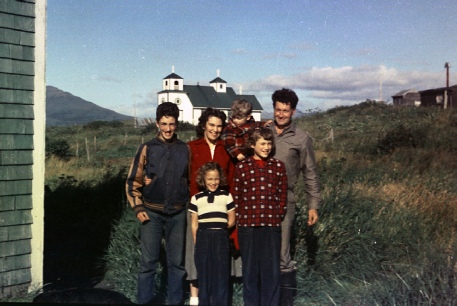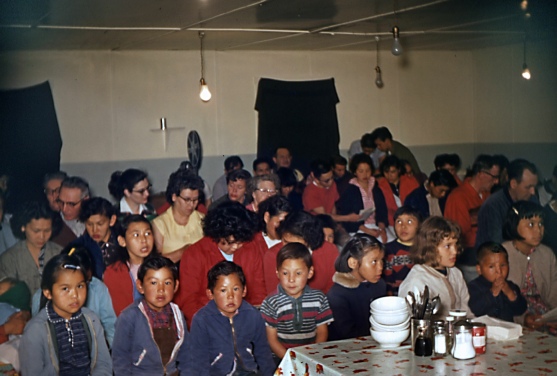Evangel Island Journey 4 -
By Timothy Smith (restored/revised 2020)
The Evangel at Akhiok and Alitak (Lazy Bay Cannery)

Akhiok in vivid Kodachrome colors in the August sun in this late 1950’s slide. The Evangel is at anchor on the right.
A Visit to Akhiok Village
The village of Akhiok is one of our regular stops as the Evangel travels around the south end of Kodiak Island. I usually don't expect to meet many kids there early in the summer. But we stop at Akhiok even though most of the population is off at Lazy Bay working in the cannery. There are people we know and regularly visit in even the smallest bear camps. For example, two of my parents’ best island friends are the couple that are caretakers for the cannery at Zachar Bay. It doesn't seem to matter much that most of the villagers are elsewhere, because the ones who remain are largely elderly, and lonely. Mom and Dad do a visitation ministry there, and save the formal services for the large population of cannery workers and children at Lazy Bay. But when we visit Akhiok in August after the fishing season, the village will be teeming with life, and we will do a full ‘shore ministry’ – meaning a Vacation Bible School and evening services – at that time. (Continued below…)

A late summer scene at Akhiok: Lots of kids involved in a day camp we put on there, relaxing after an outdoor game. This photo is from a 16mm movie frame. Joyce Smith is the tallest one on the left, smiling at the camera.
NOTE: When I showed this photo as part of my presentation to the Kodiak Maritime Museum in 2010, one of the women present came up afterwards, told me that she’d seen the photo on Tanignak.com, and that I had the only photo she’s ever seen of her grandmother as a young woman! We were living in the early days without running water, indoor plumbing, or electricity (except by our own generator), but very few people had cameras. Dad’s photos recorded what no one else did, a bit of the daily lives of people in the villages of Kodiak Island in the 1950’s and early 1960’s.
We pose for a family portrait beside the school, and near near the Russian Orthodox Church in Akhiok. Back Row: Noel (in his Kodiak High School track jacket), Joyce, Timmy (the future author of this site) being held by Norman. Front Row: Robin and Jerilynn, summer of 1957. This pose is from a 5 x 7 color print, and different from the one I used earlier. Note that “Timmy” is looking at our black Cocker Spaniel, Sootball (barely seen in the lower left). Our parent were always proud of the fact that we could make all our journeys and have all those adventures on the Evangel together as a family.

On to Lazy Bay Cannery (Alitak): Very Busy at Lazy Bay!

Lazy Bay Cannery in Alitak Bay in the early 1950’s.
Lazy Bay is probably my favorite cannery to visit. First, it has lively and enthusiastic young people who actively appreciate our arrival. Second, I have a friend that I’ve played with several years in a row, whose dad works at the cannery. And third, the scenery of the place is spectacular. A military lookout hut high on the mountain and the remains of Army barracks along the hills above the cannery give me a lot of exploration opportunities. I’m not old enough to work here, so what’s not to love? (Continued below…)
A view of Lazy Bay cannery from part way up the mountain. The red paint on the buildings
indicates the photo was taken in the early 1950’s. The white foamy-

Above are two of my favorite “Evangel In Action” photos: Our advance welcoming committee
of kids, waiting on the dock as we tie up. The white-


When we tie up at the dock, I find there’ll be no need for announcing our presence, because a small crowd of kids are already waiting for us at the dock. In addition, the cannery superintendent quickly welcomes us and gives us lots of help. He has very little if anything for the children to do while their parents are at work in the cannery or on the seiners. Our visit will provide some badly needed activities for those kids. I quickly find my friend, and we get some plywood and timbers from a scrap pile and build ourselves a fort. Then we amuse ourselves by smashing things at the trash dump, which is just a big square of pilings on the beach with netting to hold the garbage until the tide can wash it away. It’s going to be years before a more sane approach to cannery waste is implemented around the islands. Both the gurry and the beach trash will eventually go away, to pet food and to landfills respectively, but I won’t be back here to see that. So the floating gurry is awful, but the cans and bottles are good to smash with rocks down on the beach. It’s two boys’ idea of fun until we can think of something else to do.
(Continued below…)

Taking a break: the crew from a power barge (surplus military power scow) makes ice cream on the Lazy Bay dock while my sister Jerilynn (left, in green) looks on. The bag contains rock salt, and the square tub contains ice. The men are cranking the largest homemade ice cream makers I’ve ever seen. 1953 photo
When I go back to the boat for lunch, I find that it’s time to get to work for awhile.
Soon we are all busy unpacking things on the Evangel to get ready for “Vacation Bible
School” (or VBS in missionary-
Then Mom starts with a Bible story lesson using a truly high-
There are more easy songs to sing, with Dad doing the hand motions and Mom using
the pump organ, and most everybody joins in and seems to enjoy it. Dad moves on to
the filmstrip. The first one is a cartoon-
Before we close down for lunch, we have to show another filmstrip by popular demand.
This time it's about a squirrel who is greedy and won't forgive (the “Parable of
the Unrighteous Steward,” in case you didn't notice!) There are a few more songs,
and a prayer, and Mom produces some eagerly-

The crowded Lazy Bay cannery mess hall, in the middle of an evening service, summer of 1953.
This is a very evocative photo for me, reminiscent of so many evening services in so many places that the Evangel went. Dad rarely took pictures in the middle of a service; he was otherwise occupied. It’s likely my older brother Noel borrowed the camera. Here we see my sister Robin near the table, behind the silverware jar. Two rows behind, adults are sharing hymnbooks. In the background is a movie reel on the projector, ready to roll, and the windows are already blacked out. The focus is more on adults (except for the movie) and some of the kids look a little puzzled, while others are trying out the songs.
It takes only a few minutes once we get access to the mess hall to set up our things, because lots of kids volunteer to help. A few of the tables are shoved aside, and benches are put into neat little rows. Dad has some black cloth to cover the windows (the sun won't go down for another few hours, because this is summertime!) This service is also a tiny bit more formal, because Dad and Mom are using hymnbooks. But it is only the “Youth Sings,” full of peppy (for the 50’s) church music like “Do Lord,” “I'll Be Somewhere Listening,” “Walking With Jesus,” and “This World is Not My Home.” I know every song and every page number! Dad shares some scripture verses and talks about how Jesus called the fishermen to follow him, and what that means to us. It's not really a sermon, but more like a conversation. It wouldn't be too simple for any of the adults, yet every child can follow it.
Then Dad pulls up the portable movie screen and starts the projector. We have exactly
one Christian movie to show, a melodramatic black and white one-
Since many kids are still hanging around, Dad announces that after tomorrow morning's
Vacation Bible School session, he will bring out some more movies. They are all black
and white, and about ten minutes each (Castle Films?), about the Grand Canyon, a
circus with a human cannon, and a safari in Africa complete with a lion charge, all
accompanied by breathless newsreel-
We stay at Lazy Bay for several days, because there are a lot of kids there who appreciate a break from boredom. One evening after the service, Dad and I take a hike. Naturally it is still sunny out, and will be until after my bedtime. Directly above the cannery is a mountain, and far up the mountain is a World War II lookout post. It is probably not that high up, but it seems so to me as a young child. There are still Quonset huts, barracks, and the remains of a mess hall on the sides of the hill, and I have wanted to climb up to the observation post for several years now. So up we go, following the partially exposed telephone and electric cables that still stretch up to the lookout.
We climb into the building and notice the caved-
The next article is “The Evangel Visits Karluk.” To go back to the Evangel Index, please click on the logo below:



To Find Out More About Tanignak.com, Click HERE
To Visit My “About Me” Page, Click HERE

To Get Back “Home”
Please Click on the Site Logo Below:
What’s It Like to Work in a Cannery?
To Read About the Author’s Experiences as a Cannery Worker in Kodiak in the 1970’s, Please Click on the “Cannery Work” Logo to the Right
Note: the author has NO current information about cannery jobs in Alaska!



A Kodiak Airways Grumman Goose prepares to leave the beach at Akhiok, 1969 or 70. Newer homes (such as the two left and center), a new school building, and new city water and sewer are signs of a steadily more modern community. Dirk Sundbaum photo